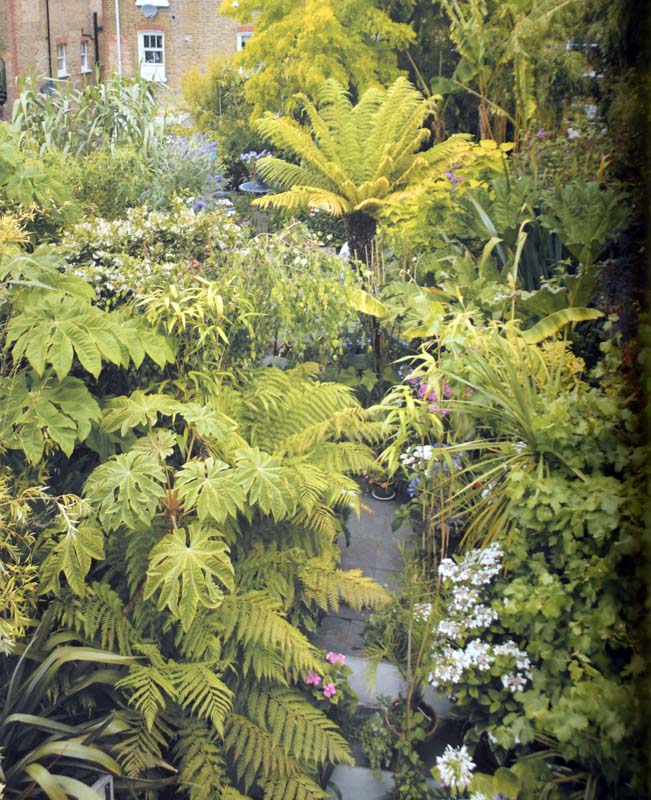Book Review
Philip Oostenbrink writes of the jungle style of garden which has become very popular over recent years especially so with those who have relatively small garden space attached to an urban house for it creates an area of sanctuary, enclosure, privacy, of withdrawal and of transport to a setting which contrasts completely with today’s dense city living. It provides an escape, an other-worldliness, a place which differs strikingly from everyday life in the concrete jungle. It might well be considered the most perfect style of gardening for the vast majority of today’s small-space, plant-loving gardeners.
This “Jungle” gardening has certainly become very fashionable in recent years but I am inclined to bristle a little at the use of the term, feeling it is both inaccurate and misleading – and, indeed, some of the gardens used as exemplars in the book are certainly far from jungle – and think that “Foliage Gardens” might be more suited and the author’s constant emphasis throughout the book is on choice of foliage. Foliage gives an enormous length of interest in the garden while flowers and fruit are merely seasonal; foliage is present for far longer and makes a more significant contribution to the garden and the author enthusiastically and very knowledgeably encourages readers to recognise and embrace this emphasis in their choice of plants and illustrates wonderfully the outstanding effects which can be created with such an approach.

After the usual introductory chapter, which clarifies that the aim of the book is to convince us of the value of the use of foliage in the garden and of the superbly pleasing and aesthetic results we can achieve, we have a further five chapters which lead us through a consideration of the various plants we might use and of the effects they will provide. There is a discussion of leaf types – shape, colour, variegation, size and combinations – followed by advice and recommendations of plants for various situations – sunny, dappled shade or full shade. We all enjoy a peep into other people’s gardens and a chapter on “Jungle Perfection” is just that, a beautiful selection of eight excellent gardens which are certain to convince all readers of the beauty which can be achieved by giving preference to foliage when designing and planting our gardens. Two practical chapters follow with one giving the practical advise which will guarantee success in cultivating these foliage plants and a final chapter which lists an A – Z of suitable jungle plants.
One apparent contradiction is effectively dispelled throughout the book and this is our inclination to choose smaller plants or plants with smaller foliage if we garden in a small place. Larger plants, with larger foliage, give that feeling of being “within” a garden most effectively. They also serve to blur the boundaries of a garden, giving the sense of an endless space. Large trees such as Catalpa, Paulownia and Liriodendron – pollarded to create vigorous growth with larger foliage – feature throughout and give excellent results. As might be expected, other presently fashionable plants, also feature for who could be without their Bananas, bamboos, Tetrapanax, Aralias, Pseudopanax, or Schlefferas! These are the sine qua non plants of the jungle garden, it would seem.
As is perfectly appropriate, and superbly effective, this book is lavishly illustrated with the excellent photographs of Sarah Cuttle which complement and bring the text to life. They serve to carry the narrative very effectively and certainly fulfil the “picture paints a thousand words”’ idiom with great style.
In his foreword, Tom Hart Dyke comments: “The Jungle Garden is a masterclass in enthusing and audience of all levels of plants knowledge, whatever growing space you are blessed with and illustrates that the rules of gardening are there to be broken, whether pushing the boundaries of hardiness, aspect, soil or particularly in this context, plant combinations (deliberate or accidental!).”
I could hardly disagree with Tom Hart Dyke!
[The Jungle Garden, Philip Oostenbrink, photography by Sarah Cuttle, Filbert Press, 2021, Hardback, 224 pages, ISBN: 978-1-9997345 -6-5, £25]








